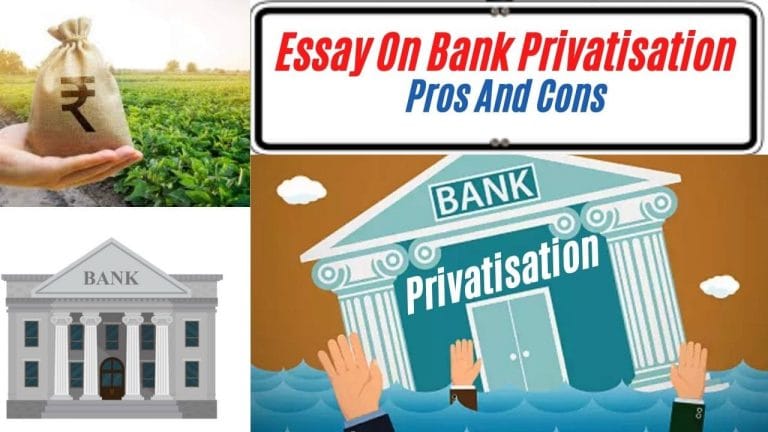"Advertisement"
Essay On Bank Privatisation Pros And Cons {Step by Step Guide}
Hello My Dear Friends, In this post “Essay On Bank Privatisation Pros And Cons“, We will read the Privatisation of Bank as an Essay In Details. So…
Let’s Start…
Essay On Bank Privatisation
Introduction
Privatization means selling Whole or Partially a Govt. Sector Company to Private Sector. Or in Other Words, Transferring Ownership to Private Sector. This Step Was also taken in 1991 in New Economic Reform to Reform India’s Economy.
Privatization is considered to bring efficiency and accuracy to a company. The market share of private banks on loans has risen to 36% by 2020 from 21.26% in 2015, while the share of public sector banks has dropped to 59.8% from 74.28%.
Competition has intensified after the RBI has allowed more independent banks since the 1990s. PSBs have higher NPAs than private sector banks. PSBs have underperformed in comparison to private banks.
Body Part
PM Narendra Modi said that it is the responsibility of the government to give full support to the enterprise and business of the country. But the government itself should run the enterprise and remain its owner, in today’s era it is neither necessary nor is it possible.
The government’s focus should be on the projects related to people’s welfare and development. PM Narendra Modi also said that such a system has to be created in the country, in which there is no lack of government and there is the influence of the government.
Along with the investment, private sectors also bring top-quality manpower, management, as well as global best practices. And this makes things more modern, modernization takes place in the whole sector, the sector expands rapidly and new job opportunities are also created.
Therefore, by monetize and modernize we can increase the efficiency of the entire economy more.
Currently, the government is reportedly looking into the possibility of Punjab & Sind Bank, Maharashtra Bank, and the Indian Overseas Bank, which is currently not part of the existing consolidation program.
It is noteworthy that, there are twelve state-owned banks in India and this comes after a recent merger involving the merger of ten government lenders in four banks. The government wanted the merger of the banks so that they could increase their competition.
Niti Aayog reportedly suggested that the government provide a green flag for “long-term private capital” in the banking sector. Also, it is recommended to provide banking licenses to a few who have built industrial houses with clear instructions that they do not lend to group companies.
According to the Reserve Bank of India’s (RBI) policy on universal banking licenses, large industrial houses are allowed to enter 10 percent but are not eligible as “eligible entities” facilities for operating banks.
The ownership and management of state-owned banks are regulated by the Banking Companies (Acquisition and Transfer of Undertakings) Act, 1970.
Also Read:
Why Banks Privatise and What Will Be Its Impact
Improving the Efficiency and Performance of Public Sector Banks (PSBs) is a key element of India’s economic transformation. It is believed to help improve performance and performance.
India is the Largest Country in Southeast Asia with a Large Financial System represented by many financial institutions. India’s financial sector was well developed even before the country’s political independence in 1947.
Bank Privatisation Pros And Cons
Pros Of Privatisation | Cons Of Privatisation |
|
|
|
|
|
|
|
|
|
|
|
|
|
|
How To Privatise Banks
Public companies can be converted into private companies in two ways:
- One option is to sell a controlling stake to a private entity in India.
- The second option for the government is to let its equity States in public sector banks drop below 50%.
Conclusion (Essay On Bank Privatisation)
Any large-scale privatization of public sector banks appears to be fraught with problems. and In the medium term, the best solution is improving governance at public sector banks.
Good, timely as transparent appointments are required at PSBs. Adequate tenure is required to give to chief executive officers. Good quality independent directors are required on PSB boards.
The government is required to play as a regulator rather than the director of the bank. And nudge the PSB management through government nominees rather than through the department of financial services.
Thanks For Reading “Essay On Bank Privatisation Pros And Cons“.
Read:
